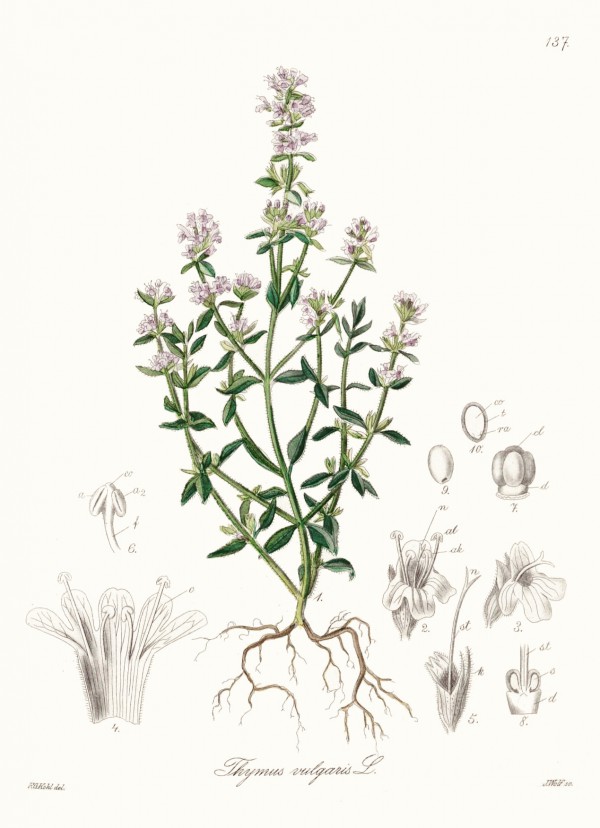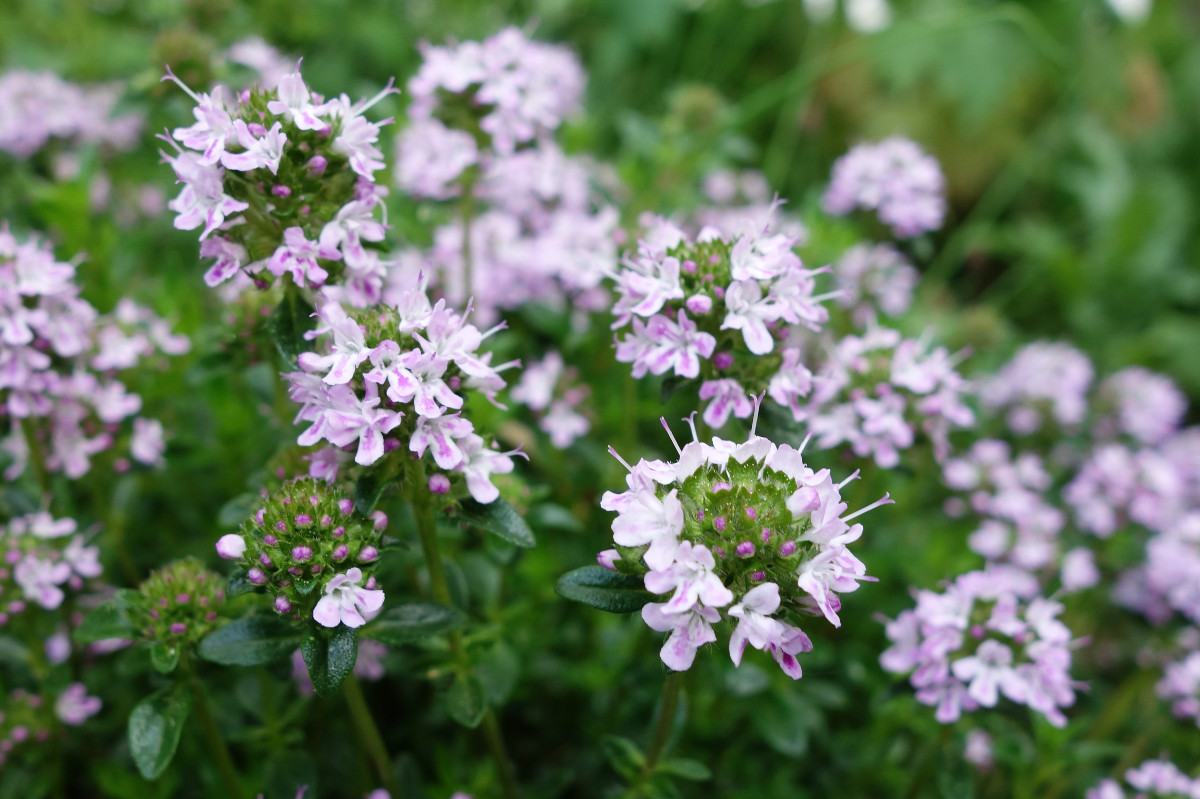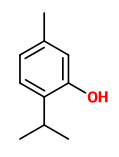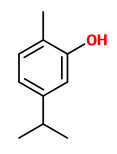Thymus vulgaris L. - Lamiaceae - common thyme, french thyme, garden thyme, Echter Thymian, Gartenthymian
Evergreen dwarf shrub, native to the western Mediterranean region, naturalizde in Europe, 20-40cm high; square erect twigs, much branched, woody at the base; leaves opposite, lanceolate or ovate, the margins revolute, the underside hoary; flowers pale pink to violet.
„The German Commission E recognized the medical use of essential thyme oil against catarrh of the upper respiratory tract, bronchitis and whooping cough. Essential thyme oil has been proven in laboratory testing antiviral and antibacterial agent, but clinical studies on its effectiveness are missing.“
http://de.wikipedia.org/wiki/Echter_Thymian
There are numerous chemical races with various dominant components present in the essential oil (1.5-4%, french cultivars up to 6.5%): thymol, carvacrol, p-cymene, linalool and its acetate, alpha-terpineol, campher, geraniol and geranyl acetate. Oils of commerce are dominated by thymol (30-50%), accompanied by p-cymene (15-20%), γ-terpinene (5-10%) and carvacrol (1-5%). The quality standard of Ph.Eur. defines contents of thymol (36-55%), accompanied by p-cymene (15-28%), γ-terpinene (5-10%), linalool (4-6.5%), carvacrol (1-4%) and terpinen-4-ol (0.2-2.5%).
[Gewürzdrogen., Teuscher, E., Bauermann, U., Werner, M., Wissenschaftliche Verlagsgesellschaft, 2003, 386-391]
„Thymol and carvacrol, with oregano, thyme, and spicy notes, were identified as key compounds contributing to the aroma of thyme leaves.“
[Volatile components and key odorants of fennel (Foeniculum vulgare Mill.) and thyme (Thymus vulgaris L.) oil extracts obtained by simultaneous distillation-extraction and supercritical fluid extraction. Díaz-Maroto, M. C., Díaz-Maroto Hidalgo, I. J., Sánchez-Palomo, E., Perez-Coello, M. S., Journal of agricultural and food chemistry, Vol.53(13), 2005, 5385-5389]
„In the essential oil of thyme, 52 compounds were identified, representing 91.4% of the total oil, the major constituents being terpinen-4-ol (13.15%), γ-terpinene (9.21%), cis-sabinene hydrate (7.65%), linalool (7.12%) and p-cymene (5.75%). Tomaino et al. reported that the major constituents of thyme essential oil were thymol (45.3%), p-cymene (26.1%) and linalool (6.17%).“
[Chemical Composition of the Essential Oils Obtained From Some Spices Widely Used in Mediterranean Region. Manuel Viuda-Martos, Yolanda Ruíz-Navajas, Juana Fernández-López, José Angel Pérez-Álvarez, Acta Chim. Slov. 921 2007, 54, 921-926]
Four chemotypes (thymol, linalool, geraniol, thujanol) of T.vulgaris were studied by GC-MS. Essential oils of ct.thymol (10 samples) contained mainly thymol (28-62%), p-cymene (13-25%), and γ-terpinene (5-14%); ct.linalool (30 samples) contained mainly linalool (33.0-86.0%), trans-thujanol (tr-8.8%), and linalylacetate (0.6-9.2%); ct. geraniol (20 samples) contained mainly geraniol (13.0-67.0%), geranylacetate (1.0-58.0%), linalool (1.0-50.0%), and terpinen-4-ol (0.2-12.0%). One sample of the thujanol chemotype contained trans-thujanol (41.0%).
[Darstellung der Variationsbreiten von Inhaltsstoffen ätherischer Öle ex Thymus vulgaris L. innerhalb verschiedener Chemotypen, Wissenschaftsprojekt für „thescenteddrop“, Forum Essenzia e.V., 2013] https://www.forum-essenzia.org/downloads/scenteddrop_thymian_2013.pdf
„The basic components of the studied thyme oil were thymol (41.33%), p-cymene (18.08%), and γ-terpinene (13.12%). According to Burt (2004), thyme oil consists of 10%-64% thymol and 10%-56% p-cymene.“
[Essential oil of Thymus vulgaris L. and Rosmarinus officinalis L.: Gas chromatography-mass spectrometry analysis, cytotoxicity and antioxidant properties and antibacterial activities against foodborne pathogens. Miladi, H. , Slama, R. , Mili, D. , Zouari, S. , Bakhrouf, A. and Ammar, E., Natural Science, Vol.5, 2013, 729-739] http://file.scirp.org/Html/9-8302003_33090.htm
Rotundone (5 μg/kg, peppery) is present well above its aroma detection threshold (8 ng/L in water) and apparently important to the flavour of thyme.
[Wood, C., Siebert, T. E., Parker, M., Capone, D. L., Elsey, G. M., Pollnitz, A. P., Herderich, M. J. (2008). Spice up your life–The Rotundone story. Expression of Multidisciplinary flavour science, Proceedings of the 12th Weurman Symposium.]
„In thymol, carvacrol, p-cymene and thymohydroquinone biosynthesis, geranyl diphosphate (GDP) is first cyclized to γ-terpinene by the terpene synthase (TvTPS2). P450s hydroxylate γ-terpinene either at C-3 or C-6, and the dienol intermediates are converted by a short-chain dehydrogenase (SDR) to the corresponding ketones. These allylic ketones undergo keto-enol tautomerisms to form thymol and carvacrol.“
[„The biosynthesis of thymol, carvacrol, and thymohydroquinone in Lamiaceae proceeds via cytochrome P450s and a short-chain dehydrogenase“, Sandra T. Krause, Pan Liao, Christoph Crocoll, Benoît Boachon, Christiane Förster, Franziska Leidecker, Natalie Wiese, Dongyan Zhao, Joshua C. Wood, C. Robin Buell, Jonathan Gershenzon, Natalia Dudareva, Jörg Degenhardt; Proceedings of the National Academy of Sciences Dec 2021, 118 (52) e2110092118; DOI: 10.1073/pnas.2110092118] https://www.pnas.org/content/118/52/e2110092118

Kohl,F.G., Die officinellen Pflanzen der Pharmacopoea Germanica, t.137 (1891-1895)
http://plantgenera.org/species.php?id_species=1016624

Thymus vulgaris cultivar, CC BY-SA 3.0, Author: Andreas Kraska






